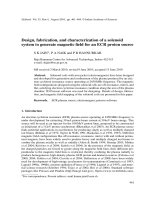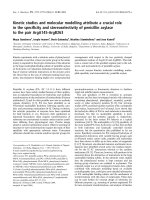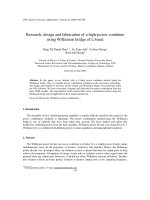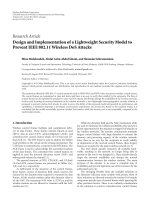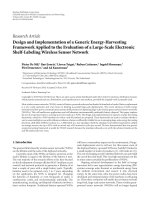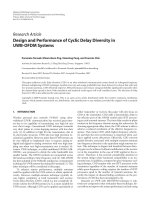Design and applications of phosphine ligands to transition metal catalyzed reactions
Bạn đang xem bản rút gọn của tài liệu. Xem và tải ngay bản đầy đủ của tài liệu tại đây (4.99 MB, 193 trang )
DESIGN AND APPLICATIONS OF PHOSPHINE
LIGANDS TO TRANSITION METAL-CATALYZED
REACTIONS
JIANG CHUNHUI
NATIONAL UNIVERSITY OF SINGAPORE
2014
DESIGN AND APPLICATIONS OF PHOSPHINE
LIGANDS TO TRANSITION METAL-CATALYZED
REACTIONS
JIANG CHUNHUI
(M.Sc., Nanjing Univ.)
A THESIS SUBMITTED FOR THE DEGREE
OF DOCTOR OF PHILOSOPHY
DEPARTMENT OF CHEMISTRY
NATIONAL UNIVERSITY OF SINGAPORE
2014
Acknowledgements
I would like to express my sincere gratitude to all the people who have helped
and inspired me during my PhD studies in the past 4 years. Without their supports,
this thesis could not have been accomplished.
Foremost, I would like to thank my supervisor, Prof. Lu Yixin, for offering all
his enthusiasm and guidance throughout my studies. His profound knowledge,
patience and motivation inspire me a lot and will accompany me in my future career.
Besides my advisor, I am deeply indebted to Prof. Tamio Hayashi for his sharing
of knowledge and intellectual discussions.
Every member of Prof. Lu’s group has been extremely supportive and I really
appreciate their support and encouragement. I especially thank Dr. Yao Weijun, Dr.
Vasudeva Rao Gandi, Dr. Wang Tianli, Dr. Liu Xiaoqian, Dr Luo Jie, Dr. Han
Xiaoyu, Dr. Zhong Fangrui, Dr. Chen Guoying, Dr. Jacek Kwiatkowski, Dr. Dou
Xiaowei, Wen Shan, Wong Yee Lin, Zhou Xin, Zhou Bo and other labmates for their
help during my PhD studies.
I also want to thank NUS for the research scholarship and financial support.
Thanks also go to all the staff in NMR, Mass, and X-Ray labs for their help.
Last but not least, I am extremely grateful to my beloved wife, Li Qing, and my
little angel, Jiang Run-xi, for always standing by me and supporting me wordlessly. I
thank to my parentsinlaw for taking care of my small family without me around.
My gratitude also goes to my parents and sister for their endless love and support.
iii
Table of Contents
Thesis Declaration i
Acknowledgements ii
Table of Contents iii
Summary vi
List of Tables viii
List of Figures ix
List of Schemes x
List of Abbreviations xiv
List of Publications xvii
Chapter 1 Introduction 1
1.1 Historical background of asymmetric palladium catalysis 1
1.2 Palladium-catalyzed asymmetric additions 5
1.2.1 Asymmetric 1,4-additions 6
1.2.2 Asymmetric 1,2-additions 18
1.2.2.1 Imine substrates 18
1.2.2.2 Aldehydes and ketones as the substrates 24
1.2.2.3 Olefin substrates 29
1.2.3 Asymmetric cycloadditions 32
1.2.4 Asymmetric 1,6-additions 36
1.3 Project objectives 36
Chapter 2 High Performance of a Palladium Phosphinooxazoline Catalyst in
Asymmetric Arylation of Cyclic N-Sulfonyl Ketimines
2.1 Introduction 39
iv
2.2 Results and discussions 44
2.2.1 Catalytic system comparison 44
2.2.2 Reaction monitoring 49
2.2.3 Substrate scope 51
2.2.4 Derivation 57
2.3 Conclusions 57
2.4 Experimental section 57
2.4.1 General information 57
2.4.2 Ketimines 58
2.4.3 Palladium-Catalyzed Asymmetric Arylation of Ketimines 61
Chapter 3 Palladium(II)/PHOX Complex-Catalyzed Asymmetric Addition of
Boron Reagents to Cyclic Trifluoromethyl Ketimines: An Efficient
Preparation of Anti-HIV Drug Analogues
3.1 Introduction 104
3.2 Results and discussions 110
3.2.1 Catalyst screening 110
3.2.2 Substrate scope 113
3.2.3 Determination of absolute configuration 116
3.3 Conclusions 116
3.4 Experimental section 117
3.4.1 General information 117
3.4.2 Synthesis of cyclic N-triflouromethyl ketimine 118
3.4.3 Palladium-catalyzed asymmetric arylation of ketimines 118
3.4.4 X-ray crystallographic analysis of 3-23am 119
3.4.5 Analytical data of dihydroquinazoline 3-23 121
v
Chapter 4 Development of New Phosphine Ligands Derived from Amino Acids
and Their Applications in Transition-Metal-Catalyzed Asymmetric
Reactions
4.1 Introduction 139
4.2 Results and discussions 145
4.2.1 Phosphine-amide ligands 145
4.2.2 Phosphine-olefin ligands 154
4.2.3 Phosphine-imine ligands 156
4.3 Conclusions 161
4.4 Experimental section 161
4.4.1 General information 162
4.4.2 General procedure for preparation of ligands 162
4.4.2.1 Phosphine-amide ligands from L-valine 162
4.4.2.2 Phosphine-amide ligands from L-threonine 164
4.4.2.3 Phosphine-peptide ligands from L-threonine 165
4.4.2.4 Phosphine-thiourea ligands from L-threonine 166
4.4.2.5 Phosphine-olefin ligands 167
4.4.2.6 Phosphine-imine ligands 168
4.4.3 General procedure for transition-metal-catalyzed reactions 169
4.4.3.1 Pd-catalyzed AAA reaction 169
4.4.3.1 Ag-catalyzed Mannich reaction 170
4.4.3.1 Rh-catalyzed1,4-addition 171
4.4.3.1 Pd-catalyzed 1,2-addition 172
vi
Summary
This thesis mainly describes the development of asymmetric palladium catalysis
in nucleophilic additions of organoboron reagents to cyclic ketimines to synthesize
chiral nitrogen-containing compounds with tertiary carbon center. In addition, this
thesis also depicts the attempts of developing new phosphine based ligands derived
from amino acids and the preliminary results of their applications in different
transition-metal-catalyzed asymmetric reactions.
Chapter 1 gave a brief historical background of asymmetric palladium catalysis.
The Inventions of three most famous reactions, “TsujiTrost reaction, MizorokiHeck
reaction and palladium-catalyzed cross-coupling,” were shortly introduced. Beside
them, the recent progress of palladium asymmetric addition was also summarized and
a selection of examples in this field were described in details, including 1,4-addition,
1,2 addition, cycloaddition and so on.
Chapter 2 demonstrated the high performance of palladium-phosphinooxazoline
catalyst in asymmetric arylation of cyclic N-sulfonyl ketimines,giving high yields of
chiral cyclic sulfonamides which bear tetra-substituted stereogenic center. A
systematic comparison between this catalytic system with others was discussed in the
main content.
Chapter 3 further studied the application of palladium-phosphinooxazoline
catalyst in asymmetric addition of organoboron reagents to cyclic trifluoromethyl
ketimines. This methodology provided an easy access to anti-HIV drug analogues
with potential biological activity.
Chapter 4 presented the development of new phosphine based chiral ligands
derived from amino acids, including phosphine-amide ligands, phosphine-peptide
vii
ligands phosphine-olefin ligands and phosphine-imine ligands. These newly
developed ligands were further screened in a series of transition-metal-catalyzed
reactions.
viii
List of Tables
Table 2.1 Catalytic Asymmetric Addition of Phenylboronic Acid (2-19m) to
Cyclic N-Sulfonyl Aldimine 2-18a and Ketimine 2-18b
47
Table 2.2 Details of monitoring the reaction process of 2-18a 49
Table 2.3
Details of monitoring the reaction process of 2-18b 50
Table 2.4
Palladium-Catalyzed Asymmetric Addition of Arylboronic Acids 2-
19m−z to Cyclic N-Sulfonyl Ketimines 2-18b−d.
52
Table 2.5
Condition screening for asymmetric addition of 2-19w to 2-18b 54
Table 2.6 Palladium-Catalyzed Asymmetric Addition of Arylboronic Acids to
Cyclic N-Sulfonyl Aryl Ketimines 2-18e−g.
55
Table 3.1 Catalytic Asymmetric Addition of Phenylboronic Acid to Cyclic N-
trifluoromethyl kestimine
110
Table 3.2 Catalytic Asymmetric Addition of Arylboronic Acid 3-22 to Cyclic N-
trifluoromethyl ketimine 3-1a
113
Table 4.1 Phosphine ligands in Pd-catalyzed AAA reaction of malonate with
allylic acetate
148
Table 4.2
Phosphine ligands in Pd-catalyzed AAA reaction of nitrophosphonate
with allylic carbamate
150
Table 4.3 Phosphine ligands in Pd-catalyzed AAA reaction of -fluoro--
ketoester with allylic carbamate
151
Table 4.4 Phosphine ligands in Pd-catalyzed AAA reaction of phthalide
derivative with allylic carbamate
151
Table 4.5 Phosphine ligands in Ag-catalyzed asymmetric Mannich reaction 153
Table 4.6 Phosphine-olefin ligands in Rh-catalyzed 1,4-addition 156
Table 4.7 Pd/phosphine-imine complex catalyzed asymmetric arylation of 6-
membered cyclic imine
160
ix
List of Figures
Figure 3.1 ORTEP structure of dihydroquinazoline 3-23am 116
Figure 4.1
31
P NMR study on coordination between Rh catalyst and phosphine-
olefin ligand
157
x
List of Schemes
Scheme 1.1 The catalytic cycle of Wacker process 2
Scheme 1.2 The Tsuji-Trost reaction 2
Scheme 1.3 Palladium-catalyzed Mizoroki-Heck reaction 4
Scheme 1.4 Transition Metal-catalyzed cross-coupling 5
Scheme 1.5 First example of a Pd-catalyzed 1,4-addition of organoboronic acids 6
Scheme 1.6 Difference in reactivity between neutral Pd- and Rh- enolates 7
Scheme 1.7 Pd/dppe complex catalyzed 1,4-addition of boronic acids 7
Scheme 1.8 Pd-catalyzed asymmetric 1,4-addition of organoboron reagents to
-saturated ketones
8
Scheme 1.9 Miyaura’s representative work on Pd-catalyzed asymmtric 1,4-additions 9
Scheme 1.10 Pd-catalyzed asymmetric arylations of -unsaturated carbonyls 10
Scheme 1.11 Palladacycles as catalysts for asymmetric 1,4-addition 11
Scheme 1.12 NHC/Pd(II) complex catalyzed asymmetric 1,4-addition 11
Scheme 1.13
Pd/pyrox catalyzed 1,4-additions to -substituted cyclic enones 12
Scheme 1.14
Pd-catalyzed asymmetric addition of Ph
2
PH to -aryl enone 13
Scheme 1.15
Pd-catalyzed asymmetric additions of diphenylphospine to -
unsaturated carbonyl compounds
14
Scheme 1.16
Asymmetric 1,4-addition of HPPh
2
reported by Leong et al. 15
Scheme 1.17 Arylsiloxanes as nucleophiles in Pd-catalyzed 1,4-addition 15
Scheme 1.18 Anilines as nuclephiles in Pd-catalyzed asymmetric 1,4-additions 16
Scheme 1.19 Pd-catalyzed enantioselective protonation via 1,4-addition 17
Scheme 1.20 Pd-catalyzed enantioselective Friedel-Crafts alylation 17
xi
Scheme 1.21 Sodeoka’s work on Pd-catalyzed asymmetric addition of -
ketoesters to imines
19
Scheme 1.22 Asymmetric arylations of imines by Lu et al. 20
Scheme 1.23 Shi’s work on Pd-catalyzed asymmetric additions to Ts- and Boc-
imines
21
Scheme 1.24 Bisoxazolines as ligands in Pd-catalyzed asymmetric additions to
imines
22
Scheme 1.25 Pd-catalyzed enantioselective additions of nitriles to N-tosylimines 22
Scheme 1.26
Pd-catalyzed asymmetric allylation of imines 23
Scheme 1.27
Pd-catalyzed 1,2-addition of malonates to cyclic imines 24
Scheme 1.28 Pd-catalyzed enantioselective arylation of boronic acids to
cyclic ketimines 24
Scheme 1.29 Qin’s work on the asymmetric addition of boronic acids to
isatins 25
Scheme 1.30 Shi’s work on the asymmetric addition of boronic acids to
isatins 25
Scheme 1.31 Pd-catalyzed enatioselective ene and aldol reactions 26
Scheme 1.32
Pd-catalyzed asymmetric hydroxymethylation of -keto ester 27
Scheme 1.33
Comparison between NHC based ligands and P-imine ligands in Pd-
catalyzed asymmetric allyations of aldehydes
28
Scheme 1.34 Pd-catalyzed enantioselective arylation of aldehydes with arylboronic
acids
29
Scheme 1.35 Pd-catalyzed asymmetric addition of B
2
(pin)
2
to allenes 29
Scheme 1.36
Enantioselective Pd-catalyzed difunctionalizations of alkenes 30
Scheme 1.37 Pd-catalyzed intramolecular cyclization via asymmetric additions to
olefins
31
Scheme 1.38 Pd-catalyzed asymmetric hydrocarbonation of allenes 32
xii
Scheme 1.39 Pd-catalytic asymmetric addition of arylboronic acids to cumulenes 32
Scheme 1.40 Lu’s work on Pd-catalyzed asymmetric cycloadditions 33
Scheme 1.41 Pd-catalyzed asymmetric arylative cyclization of allenyl aldehyde 34
Scheme 1.42 Pd-catalyzed enantioselective [2+2] cycloaddition 34
Scheme 1.43 Pd-catalytic enantioselective oxidative cascade cyclization 35
Scheme 1.44 Pd-catalyzed asymmmetric [3+2] cyclization 35
Scheme 1.45 Duan’s work on Pd-catalyzed asymmetric 1,6-addition 36
Scheme 2.1 Hayashi’s work on Rh-catalyzed asymmetric addition to N-sulfonyl
ketimines
40
Scheme 2.2 Lam’s work on Rh-catalyzed asymmetric addition to N-sulfonyl cyclic
imines
41
Scheme 2.3 Xu’s Sulfur-olefin ligand in asymmetric addition to N-sulfonyl cyclic
imines
41
Scheme 2.4 Zhang’s work on Pd-catalyzed arylation of cyclic imines 42
Scheme 2.5 Reactivity and utility of cyclic N-sulfonyl imines 43
Scheme 2.6 Ring-opening of the asymmetric arylation products 2-20 44
Scheme 3.1 Structures of Efavirenz, DPC 961 and DPC 083 105
Scheme 3.2
Zn(OTf)
2
promoted asymmetric alkynylation of ketimine 105
Scheme 3.3
Proline catalyzed asymmetric Mannich reaction of alkyl ketone and
ketimine
106
Scheme 3.4 Bifunctional cinchona thiourea catalyzed asymmetric aza-Henry
reaction of ketimines and derivation to DPC 083
107
Scheme 3.5
Ma’s work on asymmetric reactions of ketimines and synthesis of DPC
083
108
Scheme 4.1 Kagan’s DIOP and Knowles’ DiPAMP ligands 140
xiii
Scheme 4.2 Examples of privileged chiral ligands 141
Scheme 4.3 Amino acid derived chiral ligands: rigid versus flexible 143
Scheme 4.4 Gilbertson’s phosphorus containing peptide ligands 144
Scheme 4.5 Achiwa’s phosphine-amidine ligand in Pd-catalyzed AAA reaction 144
Scheme 4.6 Morimoto’s extension of Achiwa’s phosphine-amidine ligand 144
Scheme 4.7 Phosphine-amide ligands derived from amino acids 147
Scheme 4.8 Phosphine-olefin ligands derived from amino acids 156
Scheme 4.9 Phosphine-olefin ligand in Pd-catalyzed AAA reaction 157
Scheme 4.10
Phosphine-imine ligands in Pd-catalyzed AAA reaction 158
Scheme 4.11
Pd/phosphine-imine complexes 159
Scheme 4.12 Pd/phosphine-imine complex catalyzed asymmetric arylation of tolsyl
imine
159
Scheme 4.13 Pd/phosphine-imine complex catalyzed asymmetric arylation of 5-
membered cyclic imine
161
Scheme 4.14 Comparison between Pd/phosphine-imine and Pd/PHOX complexes 162
xiv
List of Abbreviations
Ac Acetyl
Å ångström
Aq Aqueous
Ar Aromatic
Bn Benzyl
Boc tert-Butyloxycarbonyl
br broad
Bz Benzoyl
Bu Butyl
Cat. Catalysts
Conc. Concentrated
DABCO 1,4-diazabicyclo[2.2.2]octane
DCE 1,2-Dichloroethylene
DMAP 4-Dimethylaminopyridine
DMF Dimethylformamide
DMSO Dimethyl sulfoxide
DIPA Diisopropylamine
d doublet
d.r. Diastereomeric ratio
ee Enantiomeric excess
Et Ethyl
EWG Electron-withdrawing group
xv
h Hour
HPLC High performance liquid chromatography
IPA iso-Propanol
m multiplet
m/z mass-to-charge ratio
mmol millimole
MBH MoritaBaylissHillman
Me Methyl
Ms Methyl sulfonyl
L microlitre
NR No reaction
Nu nucleophile
Ph Phenyl
Pr Propyl
ppm parts per million
q quartet
r.t. Room temperature
s singlet
TBDPS tert-butyldiphenylsilyl
TBS tert-butyldimethylsilyl
TDS thexyldimethylsilyl
TEA Triethylamine
TFA Trifluoromethylacetic acid
THF Tetrahydrofuran
xvi
TIPB 1,3,5-Triisopropylphenyl
TPS Triphenylsilane
TS Transition state
Ts (Tos) p-Toluenesulfonyl
t triplet
vs versus
xvii
List of Publications
1. Chunhui Jiang, Yixin Lu*, Tamio Hayashi*, “High Performance of a Palladium-
Phosphinooxazoline Catalyst in Asymmetric Arylation of Cyclic N-Sulfonyl
Ketimines," Angew. Chem. Int. Ed. 2014, Early View. (DOI:
10.1002/anie.201406147)
2. Xiaowei Dou, Bo Zhou, Weijun Yao, Fangrui Zhong, Chunhui Jiang, Yixin Lu*,
“A Facile Approach for the Asymmetric Synthesis of Oxindoles with a 3-
Sulfenyl-Substituted Quaternary Stereocenter,” Org. Lett. 2013, 15, 4920-4923.
3. Jie Luo, Chunhui Jiang, Haifei Wang, Li-Wen Xu, Yixin Lu*, “Direct
asymmetric Michael addition of phthalide derivatives to chalcones,” Tetrahedron
Lett. 2013, 54, 5261-5265.
4. Fangrui Zhong, Chunhui Jiang, Weijun Yao, Li-Wen Xu, Yixin Lu* ,
“Molecular sieve mediated decarboxylative Mannich and aldol reactions of β-
ketoacids,” Tetrahedron Lett. 2013, 54, 4333-4336.
5. Chunhui Jiang, Fangrui Zhong, Yixin Lu*, “Asymmetric organocatalytic
decarboxylative Mannich reaction using β-keto acids: a new protocol for the
synthesis of chiral β-amino ketones,” Beilstein J. Org. Chem. 2012, 8, 1279-1283.
xviii
Chapter 1
1
Chapter 1 Introduction
1.1 Historical background of asymmetric palladium catalysis
Palladium catalysis is a very important method for constructing carboncarbon
and carbonheteroatom bonds in organic synthesis and has been widely used in both
academia and industry for decades. As early as 1959, Wacker process for the
oxidation of ethylene to acetaldehyde by oxygen in water in the presence of a
tetra-chloropalladate(II) catalyst was invented (Scheme 1.1).
1
It was one of the most
important milestones in the history of organopalladium chemistry and also the starting
point of modern palladium chemistry.
2
Since then, tremendous efforts have been
devoted to this area and many new reactions have been developed based on palladium
catalysis. In recognition of the significance of this research field, the 2010 Nobel
Prize in Chemistry was awarded jointly to Richard F. Heck, Ei-ichi Negishi and Akira
Suzuki for their great contribution to palladium-catalyzed cross-coupling reactions. In
palladium catalysis, palladium-catalyzed asymmetric reactions were undoubtedly very
appealing and had drawn tremendous attention from synthetic chemists. With the
development of different chiral ligands as catalyst partners, palladium-catalyzed
reactions have been shown to be versatile in producing biologically important chiral
molecules.
1
J. Smidt, W. Hafner, R. Jira, J. Sedlmeier, R. Sieber, R. Ruttinger, and H. Kojer, Angew. Chem. 1959, 71,176.
2
J. Tsuji, J. Organomet. Chem. 1986, 300, 281.
.
Chapter 1
2
Scheme 1.1 The catalytic cycle of Wacker process
Nearly ten years after the invention of Wacker process, Tsuji reported a
carboncarbon forming substitution reaction which was later known as TsujiTrost
reaction by using (-allyl)palladium complexes in 1965.
3
Trost et al. further
advanced this process by developing an asymmetric version later.
4
The scope of this
reaction has been greatly expanded to include many different C, N, or O based
nucleophiles, and many electrophiles containing different leaving groups, as well as
many P, N, or S based ligands. In TsujiTrost reaction, palladium catalyst firstly
coordinates with the allyl group, the oxidative addition subsequently takes place to
yield chiral -allyl complex 1-2, and attack by the nucleophile leads to the final
substitution product 1-3 (Scheme 1.2).
Scheme 1.2 The Tsuji-Trost reaction
3
J. Tsuji, H. Takahashi, M. Morikawa, J. Am. Chem. Soc. 1965, 87, 3275.
4
B. M. Trost, D. L. Van Vranken, Chem. Rev. 1996, 96, 395.
Chapter 1
3
Another important carboncarbon bond forming reaction in asymmetric
palladium catalysis is asymmetric MizorokiHeck reaction (Scheme 1.3a). In the
early 1970s, Mizoroki
5
and Heck
6
independently reported a new palladium-mediated
crossing coupling of alkene with aryl halide. Interestingly, Shibasaki and Overman
also reported asymmetric examples of MizorokiHeck reaction in 1989.
7
They
achieved intramolecular cyclization by using Pd(OAc)
2
as a catalyst and (R)-BINAP
1-6 or (R, R)-DIOP 1-9 as a chiral ligand (Scheme 1.3b and 1.3c). In this
transformation, tertiary and quaternary chiral centers were generated although the
enantioselectivities were low. Following their seminal work, various new substrates
and chiral ligands were designed, and now asymmetric MizorokiHeck reaction is
one of the most efficient methods for preparation of chiral structures containing a
tertiary and quaternary stereogenic centers.
5
a) T. Mizoroki, K. Mori, A. Ozaki, Bull. Chem. Soc. Jpn. 1971, 44, 581; b) T. Mizoroki, K. Mori, A. Ozaki, Bull.
Chem. Soc. Jpn. 1973, 46, 1505.
6
R. F. Heck, J. P. Nolley Jr., J. Org. Chem. 1972, 37, 2320.
7
a) Y. Sato, M. Sodeoka, M. Shibasaki, J. Org. Chem. 1989, 54, 4738; b) N. E. Carpenter, D. J. Kucera, L. E.
Overman, J. Org. Chem. 1989, 54, 5846
Chapter 1
4
Scheme 1.3 Palladium-catalyzed Mizoroki-Heck reaction
Despite palladium-catalyzed cross-coupling reaction arrived quite late in
palladium catalysis, the impact however was significant. (Scheme 1.4a). Palladium
overcomes the disadvantages of traditional Mg or Li-mediated cross coupling, such as
limitation of unhindered alkyl halides as substrates, and the competing side
reactions.
[9d]
From 1975 to 1976, several other groups independently reported a
number of palladium-catalyzed cross-coupling reactions.
8
Subsequently that, Negishi
and co-workers systematically studied this reaction and established the foundation for
the palladium-catalyzed cross-coupling
9
In the 1980s, Hayashi et al. developed
8
a) L. Cassar, J. Organomet. Chem.1975, 93, 253; b) M. Yamamura, I. Moritani, S. I. Murahashi, J. Organomet.
Chem.1975, 91, C39; c) S. Baba, E. Negishi, J. Am. Chem. Soc. 1976, 98, 6729; d) J. F. Fauvarque, A. Jutand,
Bull. Soc. Chim. Fr. 1976, 765; d) A. Sekiya, N. Ishikawa, J. Organomet. Chem. 1976, 118, 349.
9
a) E. Negishi, A. O. King, N. Okukado, J. Org. Chem. 1977, 42, 1821; b) A. O. King, N. Okukado, E. Negishi, J.
Chem. Soc. Chem. Commun. 1977, 683; c) A. O. King, E. Negishi, F. J. Villani, Jr., A. Silveira, Jr., J. Org. Chem.
1978, 43, 358; d) N. Okukado, D. E. Van Horn, W. L. Klima, E. Negishi, Tetrahedron Lett. 1978, 1027; e) E.
Negishi, N. Okukado, A. O. King, D. E. Van Horn, B. I. Spiegel, J. Am. Chem. Soc. 1978, 100, 2254; d) E.
Negishi, in Aspects of Mechanism and Organometallic Chemistry, J. H. Brewster, Ed., Plenum Press, New York,

